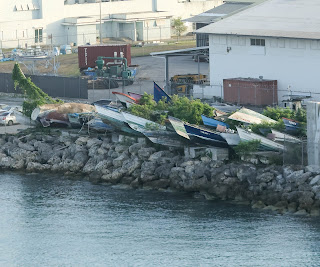The previous Blog Post had covered our arrival into Bridgetown, Barbados and the successful trip to see my first Masked Duck. with the first part of the plan completed, it was time to move on to get some better views of some Barbados Bullfinches. One of the good areas on eBird was around the Bridgetown Hilton Hotel. This was about three miles from the port, so it was easy to drop in there on the way back to the port. It was a surprisingly slow drive back to the Hilton Hotel as we got caught in a lot of slow traffic.
This cannon marks the entrance to the Pavilion Court apartment complex: This is part of the old British military hospital compound which was in use from 1789 to 1905 and it has retained a lot of its distinctive colonial look
When we arrived, I saw there was a military cemetery outside of the Hilton complex with some big trees. This looked a better option to visit, rather than to try getting into the Hilton's grounds.
A sign by the military cemetery: Obviously, that excludes the British who first colonised the island in 1625
A memorial to Barbadian merchant seamen who lost their lives in World War II: This was one in a number of interesting memorials in the cemetery. I do enjoy walking around this old cemeteries and looking at the history in the cemetery, whilst looking for Birds
I saw the first of several Barbados Bullfinches within a few minutes of entering the cemetery. This was good as I only had about a half hour of time charter left, excluding the time needed to get back to the port.
Zenaida Dove: This is the aurita subspecies which occurs on the Lesser Antilles. Two other subspecies occur on the Bahamas, the Greater Antilles, the Virgin Islands & Mexico
It was good to be able to spend a few minutes getting my eye in on these common and pretty Zenaida Doves, which I had been in too much of a rush to look at properly on Grenada & earlier in the day. But I had limited time left on my taxi charter and I carried on further into the cemetery to look for some Barbados Bullfinches. I saw one on the cemetery wall, but it dropped over the far side. Then this one popped up on a gravestone: job done.
Barbados Bullfinch: Both sexes of this endemic species looks very similar to the female Lesser Antillean Bullfinches. I saw several on the drive from Bayfield to the Hilton area as they are a tame & conspicuous species of gardens, scrubland & open woodlands
Brown Anole: This Lizard is native to Cuba & the Bahamas. However, it has been widely introduced elsewhere and it is now found in a number of Southern States of the US, as well as, other Caribbean islands, Mexico & Taiwan
I was back on the ship for a late snack lunch around mid-afternoon. After that I went back ashore with Jan to have a wander around the port area, where she was hoping to find some shops. As we walked along the approach road we failed to find any shops. But we did find a fish processing area, where one of the Fish being cleaned up were one of the local Flying Fish species. There were a few Cattle Egrets getting some easy food there.
Cattle Egret: This is the ibis subspecies which occurs in Southern Europe East to Iran, Africa, Madagascar, the Seychelles, Aldabra, the Comoros Islands & Mauritius. In the 20th Century this subspecies also colonised North & South America and was introduced to Hawaii
We gave up on the search for shops & walked back to the ship, On the way back, I spotted a Lizard which turned out to be another Brown Anole & some Hermit Crabs. While we were watching it, some other tourists from another ship spotted a gorgeous-looking, but poisonous, Frangipani Hawk Moth caterpillar.
Frangipani Hawk Moth caterpillar: The Frangipani Hawk Moth is native to the tropical & subtropical Americas from the Southern & South West US
Having failed to find any interesting shops outside of the port, Jan & I returned to the ship.
It was all very civilised with music being played which we had celebratory mid-afternoon tea & cakes in the lounge: I was happy having seen both the potential Ticks on Barbados

































































